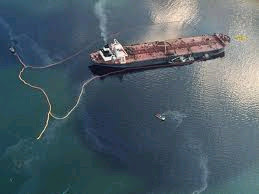Twenty two years ago today, Prince Edward Sound's pristine beauty was forever changed when the Exxon Valdez ran aground.
 We should never forget the heartbreaking images of oil slicks, fish kills, sick wildlife, etc. Nor should we ever adopt an attitude of "it can't possibly happen again." The spill in the Gulf of Mexico has taught us that that mindset is entirely misguided.
We should never forget the heartbreaking images of oil slicks, fish kills, sick wildlife, etc. Nor should we ever adopt an attitude of "it can't possibly happen again." The spill in the Gulf of Mexico has taught us that that mindset is entirely misguided.But, on the twenty second anniversary of the Exxon Valdez we should be ever mindful of the need to find ways to impact our enviornment positively - and ways to encourage our leaders to help us become more environmentally responsible as a nation.
According to DiscoveryNews, here are some note-worthy facts about the spill:
- The amount of oil spilled could fill 125 Olympic-sized swimming pools.
- As many as 2,800 sea otters, 300 harbor seals, 900 bald eagles and 250,000 seabirds died in the days following the disaster.
- 1,300 miles of coastline were hit by the oil spill.
- 1,000 harlequin ducks were killed by the oil spill, in addition to many chronic injuries that occurred as a result of the long term effects of the spill.
- The cleanup required about 10,000 workers, 1,000 boats and roughly 100 airplanes and helicopters.
- Four deaths were directly associated with cleanup efforts.
- The spill caused over $300 million of economic harm to more than 32 thousand people whose livelihoods depended on commercial fishing.
- Tourism spending decreased by eight percent in south central Alaska and by 35 percent in southwest Alaska in the year after the spill.
- There was a loss of 9,400 visitors and $5.5 million in state spending.
- Many fish populations were harmed during the spill. For example, sand lance populations went down in 1989 and 1990, herring returns were significantly fewer in 1992 and 1994 and adult fish had high rates of viral infections.
- Pink salmon embryos continued to be harmed and killed by oil that remained on stones and gravel of stream banks through at least 1993. As a result, the southwestern part of Prince William Sound lost 1.9 million or 28 percent of its potential stock of wild pink salmon. By 1992, this part of the sound still had 6 percent less of the wild pink salmon stock than was estimated to have existed if the spill had not occurred.
- Two years following the Exxon Valdez spill, the economic losses to recreational fishing were estimated to be $31 million.
- Twelve years after the spill, oil could still be found on half of the 91 randomly selected beaches surveyed.
-Three species of cormorant, the common loon, the harbor seal, the harlequin duck, the pacific herring and the pigeon guillemot still have not fully recovered.
The Encyclopedia of Earth states that there were several lessons learned by the Exxon Valdez Clean-Up project:
- Clean-up attempts can be more damaging than the oil itself, with impacts recurring as long as clean-up (including both chemical and physical methods) continues. Because of the pervasiveness of strong biological interactions in rocky intertidal and kelp forest communities, cascades of delayed, indirect impacts (especially of trophic cascades and biogenic habitat loss) expand the scope of injury well beyond the initial direct losses and thereby also delay recoveries.
- Oil that penetrates deeply into beaches can remain relatively fresh for years and can later come back to the surface and affect nearby animals. In addition, oil degrades at varying rates depending on environment, with subsurface sediments physically protected from disturbance, oxygenation, and photolysis retaining contamination by only partially weathered oil for years.
- Rocky rubble shores should be of high priority for protection and cleanup because oil tends to penetrate deep and weather very slowly in these habitats, prolonging the harmful effects of the oil when it leaches out.
- Oil effects to sea birds and mammals also are substantial (independent of means of insulation) over the long-term through interactions between natural environmental stressors and compromised health of exposed animals, through chronic toxic exposure from ingesting contaminated prey or during foraging around persistent sedimentary pools of oil, and through disruption of vital social functions (caregiving or reproduction) in socially organized species.
- Long-term exposure of fish embryos to weathered oil at parts per billion (ppb) concentrations has population consequences through indirect effects on growth, deformities, and behavior with long-term consequences on mortality and reproduction.
What is the legacy that we are leaving to our children, grandchildren and the world at large? Surely we don't want it to be one of more Exxon Valdez and Gulf Spill events. Let us never forget....








No comments:
Post a Comment